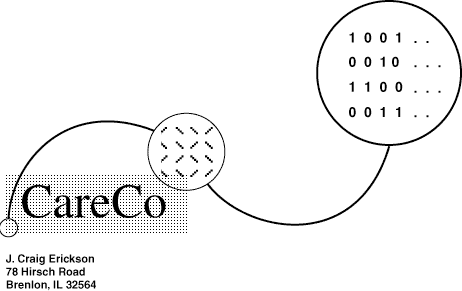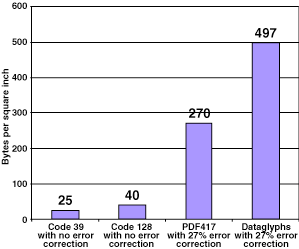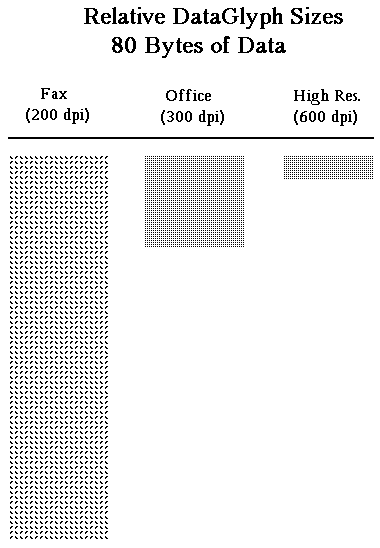|
Technical Overview of DataGlyphs®/Microglyphs®:
DataGlyphs/Microglyphs are a robust and unobtrusive method of embedding computer-readable data on a variety of surfaces.
How Data Is Encoded
DataGlyphs/Microglyphs encode information - text, data, graphics - in thousands of tiny glyphs. Each glyph consists of a 45-degree diagonal line, as short as one one-hundredth of an inch or less, depending on the resolution of the printing and scanning that's used. Each glyph represents a single binary 0 or 1, depending on whether it slopes to the right or left.
|

Leaning either forward or back, DataGlyphs/Microglyphs represents the
ones and zeroes in binary digital data.
|
|
The glyphs are laid down in groups on a regular, finely spaced grid forming unobtrusive, evenly textured gray areas. Even when individual glyphs are large enough to be resolved by the human eye, in groups they form a pleasing pattern that is not distracting.
Superior Data Density
The amount of data that can be encoded in a DataGlyph of a given size will vary with the quality of the imprinting and scanning equipment to be used.
|

DataGlyphs offer a data density nearly twice that of PDF417, one of the most popular forms of 2d barcodes.
|
For example, with one and two-dimensional barcodes, the minimum feature size that can be used is 0.0075inch - three dots at 400 dpi. At that density, and with minimal height, Code 39 (the most commonly used generalpurpose linear bar code) can only achieve a density of about 25 binary bytes per square inch. Code 128 can achieve about 40 bytes per square inch.
The two-dimensional bar codes, such as PDF417, do much better. achieves a maximum data density of 2,960 bits (or 370 binary bytes) per square inch, with no error correction, at 400 dpi. But with realistic error correction of 27%, the effective data rates for PDF417 are about 270 bytes per square inch. At the same resolution and level of error correction, DataGlyphs can carry nearly 500 bytes per square inch.
As with other visual encoding schemes, the density of DataGlyph encoding is determined by four factors:
- The resolution at which the encoding is created and scanned. High-resolution devices such as office laser printers and document scanners permit denser marking patterns, and thus denser encoding, than low-resolution devices such as dot-matrix printers and fax machines.
- The amount of error correction used. The process of printing and scanning unavoidably degrades image-encoded data. In high-density encoding, where the print and scan defects are likely to be large compared to the encoding feature size, more of the encoding features will be lost or misread as a result of such degradation. As a countermeasure, some system of redundancy must be used to keep the failure rate within reasonable bounds - that is, for error correction. And redundant coding consumes extra space, reducing the effective data density. Again, how much error correction must be employed will vary from application to application. But there must always be some in any real-world application of any encoding scheme. The data densities that can be achieved using no error correction are theoretical upper bounds, unlikely to be of practical use.
- The data compression used. Data can be compressed as it's encoded, For example, if all the data is numeric, there's no need to use one byte (8 bits) per digit, 3.32 bits will suffice. When text is encoded, it can be compressed by factors of two or more by means of character encoding or other compression techniques. For example the full text of the Gettysburg Address, often used to demonstrate high-density encoding contains 268 words, or about 1,450 characters. But the entire speech can easily be represented in less than 900 bytes.
- The fixed overhead of the synchronization frame and header. For DataGlyphs, the synchronization frame is a fixed proportion of the data area. DataGlyphs also have a very small fixed header.
|

The size of the DataGlyph required to encode 80 bytes of information depends on the device(s) to be used for printing and/or scanning. DataGlyphs for faxing are often drawn disproportionately large for added reliability in the face of the "noise" that frequently affects fax images.
|
|
|
|

License & Product Info
Xerox/Parc Dataglyphs
are exclusively licensed to
Microglyph.
Contact us for product
information.
More about PARC
Palo Alto Research Center
Industry Contributions
Additional Information:
Dataglyphs
|